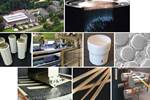Post Cure: CMC family of materials handles extreme environments
Arceon’s Carbeon materials serves to bridge the gap between research and industry, capable of handling extreme temperatures and thermal shock among other properties for defense, space and beyond.
Source | Arceon
Since its founding in 2018, (Delft, Netherlands) has been delivering on its technical prowess in carbon-silicon carbide matrix (C/C-SiC) composites.
Working alongside space, hypersonics and other industry players, the Dutch startup continues to test and validate its Carbeon family of ceramic matrix composite (CMC) materials, which are designed to handle complex engineering challenges such as extreme temperatures and thermal shock.
Arceon leverages the melt infiltration (MI) process to achieve materials and components like this solid rocket nozzle cone. The process, put simply, involves manufacturing of a CFRP part, pyrolysis to form a porous carbon fiber-reinforced carbon (C/C) preform and infiltration of molten silicon to form the C/C-SiC composite. The final part, which initially appears metallic, gives more of a matte appearance after machining.
Read more about Arceon’s technology and future plans, “Carbeon C/C-SiC ceramic matrix composites without fiber coating.”
Related Content
-
Low-cost, efficient CFRP anisogrid lattice structures
CIRA uses patented parallel winding, dry fiber, silicone tooling and resin infusion to cut labor for lightweight, heavily loaded space applications.
-
Combining multifunctional thermoplastic composites, additive manufacturing for next-gen airframe structures
The DOMMINIO project combines AFP with 3D printed gyroid cores, embedded SHM sensors and smart materials for induction-driven disassembly of parts at end of life.
-
Automated robotic NDT enhances capabilities for composites
Kineco Kaman Composites India uses a bespoke Fill Accubot ultrasonic testing system to boost inspection efficiency and productivity.



